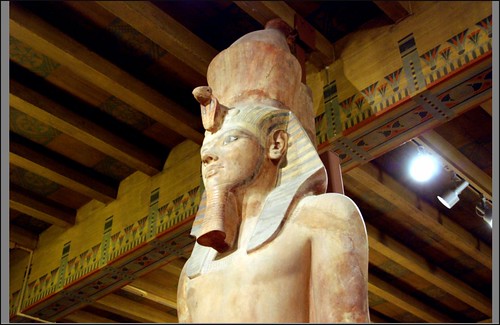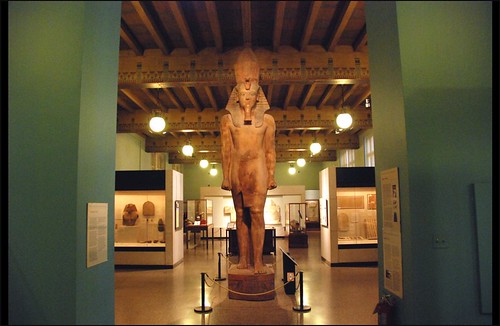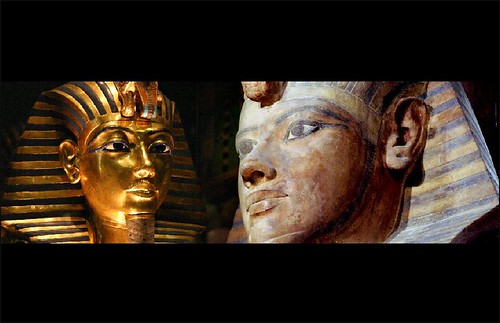
An archaeological mission of the Supreme Council of Antiquities (SCA) led by Dr. Mohamed Abdel Maqsoud, Head of Antiquities of Lower Egypt, discovered the remains of a temple of Queen Berenike, the wife of king Ptolemy III (246-222 BC), along with a cachette of 600 Ptolemaic statues.
The discovery was made during routine excavations at the Kom el Dikka area in Alexandria, in an area that belongs to Alexandria Security Forces.
Dr. Zahi Hawass, Secretary General of the SCA, said that the discovered remains are 60 meters tall and 15 meters in width and extend under Ismail Fahmy street. He explained that the temple was subjected to destruction during later eras when it was used as a quarry, which led to the disappearance of many of its stone blocks.
Dr. Abdel Maqsoud said that the mission, which includes 18 skilled excavators and restorers, unearthed a large collection of statues depicting the cat goddess Bastet, the goddess of protection and motherhood, which indicates that the temple was dedicated to this goddess.
Dr. Maqsoud pointed out that the Bastet statues were unearthed in three different areas of the site along with other limestone statues of unidentified children and women. Clay pots as well as bronze and faience statues of different ancient Egyptian deities have been also uncovered, along with terracotta statues of the gods Harpocrates and Ptah.
Early studies on site revealed that the temple's foundation can be dated to the reign of Queen Berenike, making this the first Ptolemaic temple discovered in Alexandria to be dedicated to the goddess Bastet. It also indicates that the worship of the goddess Bastet continued in Egypt after
the decline of the ancient Egyptian era.
An inscribed base of a granite statue from the reign of King Ptolemy IV (205-222 BC) was also unearthed. It bears ancient Greek text written in nine lines stating that the statue belonged to a top official in the Ptolemaic court. Dr. Maqsoud believes the base was made to celebrate Egypt's victory over the Greeks during the Battle of Raphia in 217 BC.
The mission also found a group of old structures, including a Roman water cistern, a group of 14 meter-deep water wells, stone water channels, and the remains of a bath area, well as a large number of clay pots and sherds that can be dated to the fourth century BC.
Abdel Maqsoud believes that this find is the first trace of the real location of Alexandria's royal quarter.

http://drhawass.com/blog/press-release-new-discovery-kom-el-dikka
BBC News - Templo de Dios al gato encontrado en Egipto
Traducido del: inglés
Un templo a la diosa gata Bastet es descubierto en Alejandría, sede de la dinastía Ptolemaica de Egipto.|
|
A temple to the cat goddess Bastet is uncovered in Alexandria, seat of the Egyptian Ptolemaic dynasty.
Bubastis - Wikipedia, la enciclopedia libre
BUBASTIS

Cuando los gatos fueron sagrados
Mujerárbol: Un templo de Bastet
Un templo de Bastet. >> 19 enero 2010. Se ha descubierto en Egipto, en medio de una de las calles de Alejandría, un templo del siglo IV AC (época ...
mjarb.blogspot.com/2010/01/un-templo-de-bastet.html - En cachéHallado Templo de Bastet en Alejandría - Noticias de Egiptomania ...
19 Ene 2010 ... Hallado Templo de Bastet en Alejandría ... collection of statues depicting the cat goddess Bastet, the goddess of protection and motherhood, ...
www.egiptomania.com/noticias.asp?...Templo-de-Bastet... - En cachéMundoEgiptología » Hallado Templo de Bastet en Alejandría
19 Ene 2010 ... 19/01/2010New Discovery at Kom el-Dikka An archaeological mission of the Supreme Council of Antiquities (SCA) led by Dr. Mohamed Abdel ...
mundoegiptologia.portalmundos.com/hallado-templo-de-bastet-en-alejandria/ - En cachéTemplo de la diosa Bastet Egipto Bast Cat. Arte Ta Taza de Zazzle.es
Envío dentro de las 24 horas de la mayoría de los pedidos. Templo de la diosa Bastet Egipto Bast Cat. Arte Ta Taza creado por TigerpixieArt.
www.zazzle.es/templo_de_la_diosa_bastet_egipto_bast_cat_arte_ta_taza-168050716150537391 - En cachéDescubren en Alejandría un templo de hace 2.300 años | Cultura ...
19 Ene 2010 ... Templo dedicado a Bastet La expedición ha encontrado más de 600 objetos, entre los que se encuentran figuras de bronce, piedra y terracota.
www.elmundo.es/elmundo/2010/01/19/.../1263894526.html - En cachéEl Templo de Bastet | Retroinformática, Rol y Juegos de Tablero y ...
Compra Retroinformática y Rol y Juegos de Tablero en El Templo de Bastet. También encontrarás Libros y Comics y Juguetes y Figuras. En eBay.es.
stores.shop.ebay.es › Tiendas eBay › El Templo de Bastet - En cachéGran santuario de Bastet, la diosa gato egipcia, una página ...
Gran santuario de Bastet, la diosa gato egipcia, una página dedidaca a los felinos que merecen su propio templo. Sitio web: http://www.bastetweb.com.ar/ ...
www.todoar.com.ar/ir.php?nreg... - En caché - Similares
Galería de Hans Ollermann
Oriental Institute, Chicago
2008_0923_184616AB Oriental Institute, Chicago

This statue of pharaoh Tutankhamun, one of two nearly identical colossal images, was excavated by the Oriental Institute in Western Thebes near the Temple of Medinet Habu.
It is 17 feet and 4 inches tall, and thus the tallest ancient Egyptian statue in the Western Hemisphere.. A gift of the Egyptian gouvernment to the Oriental Institute of the University of Chicago.
The other statue is in the Egyptian Museum, Cairo.
(Camera: Nikon D80)
2008_0923_184531AB Oriental Institute, Chicago

This statue of pharaoh Tutankhamun, one of two nearly identical colossal images, was excavated by the Oriental Institute in Western Thebes near the Temple of Medinet Habu.
It is 17 feet and 4 inches tall, and thus the tallest ancient Egyptian statue in the Western Hemisphere.. A gift of the Egyptian gouvernment to the Oriental Institute of the University of Chicago.
The other statue is in the Egyptian Museum, Cairo.
(Camera: Nikon D80)
2008_0923_184444AB Oriental Institute, Chicago

This statue of pharaoh Tutankhamun, one of two nearly identical colossal images, was excavated by the Oriental Institute in Western Thebes near the Temple of Medinet Habu.
It is 17 feet and 4 inches tall, and thus the tallest ancient Egyptian statue in the Western Hemisphere.. A gift of the Egyptian gouvernment to the Oriental Institute of the University of Chicago.
The other statue is in the Egyptian Museum, Cairo.
(Camera: Nikon D80)

Left: The magnificent golden mask of Tutankhamun, Egyptian Museum, Cairo.
The Metropolitan Museum of Art was giving fantastic assistance to Howard Carter, when he discovered the tomb of Tutankhamun in 1922.
Sometime ago the golden mask received hospitality in the Met during an exhibition that was organised in this great museum.
In the superb Oriental Institute of the University of Chicago, (like in almost all important Egyptian Museums in the world) photography inside the museum(without flash of course) is allowed, in Cairo not anymore since a few years. In Chicago King Tut is photographed as a star by numerous enthousiastic visitors of the Oriental Institute while Tutankhamun in a way lost his star status in Cairo where no pictures are made anymore by the disappointed visitors of the Egyptian Museum.
Right: This statue of pharaoh Tutankhamun, one of two nearly identical colossal images, was excavated by the Oriental Institute in Western Thebes near the Temple of Medinet Habu.
It is 17 feet and 4 inches tall, and thus the tallest ancient Egyptian statue in the Western Hemisphere.. A gift of the Egyptian gouvernment to the Oriental Institute of the University of Chicago.
The other statue is in the Egyptian Museum, Cairo.
(Camera: Nikon D80)

This statue of pharaoh Tutankhamun, one of two nearly identical colossal images, was excavated by the Oriental Institute in Western Thebes near the Temple of Medinet Habu.
It is 17 feet and 4 inches tall, and thus the tallest ancient Egyptian statue in the Western Hemisphere.. A gift of the Egyptian gouvernment to the Oriental Institute of the University of Chicago.
The other statue is in the Egyptian Museum, Cairo.
(Camera: Nikon D80)
It is 17 feet and 4 inches tall, and thus the tallest ancient Egyptian statue in the Western Hemisphere.. A gift of the Egyptian gouvernment to the Oriental Institute of the University of Chicago.
The other statue is in the Egyptian Museum, Cairo.
(Camera: Nikon D80)
collage Tutankhamun

Left: The magnificent golden mask of Tutankhamun, Egyptian Museum, Cairo.
The Metropolitan Museum of Art was giving fantastic assistance to Howard Carter, when he discovered the tomb of Tutankhamun in 1922.
Sometime ago the golden mask received hospitality in the Met during an exhibition that was organised in this great museum.
In the superb Oriental Institute of the University of Chicago, (like in almost all important Egyptian Museums in the world) photography inside the museum(without flash of course) is allowed, in Cairo not anymore since a few years. In Chicago King Tut is photographed as a star by numerous enthousiastic visitors of the Oriental Institute while Tutankhamun in a way lost his star status in Cairo where no pictures are made anymore by the disappointed visitors of the Egyptian Museum.
Right: This statue of pharaoh Tutankhamun, one of two nearly identical colossal images, was excavated by the Oriental Institute in Western Thebes near the Temple of Medinet Habu.
It is 17 feet and 4 inches tall, and thus the tallest ancient Egyptian statue in the Western Hemisphere.. A gift of the Egyptian gouvernment to the Oriental Institute of the University of Chicago.
The other statue is in the Egyptian Museum, Cairo.
(Camera: Nikon D80)
Visit to the Oriental Institute, Chicago

This statue of pharaoh Tutankhamun, one of two nearly identical colossal images, was excavated by the Oriental Institute in Western Thebes near the Temple of Medinet Habu.
It is 17 feet and 4 inches tall, and thus the tallest ancient Egyptian statue in the Western Hemisphere.. A gift of the Egyptian gouvernment to the Oriental Institute of the University of Chicago.
The other statue is in the Egyptian Museum, Cairo.
(Camera: Nikon D80)
AVISO: Se declina toda responsabilidad derivada de las afirmaciones que puedan ser sostenidas por los/as autores/as de los mensajes a esta lista, quienes deberán hacerse cargo, en su caso, del contenido de los mismos. Para escribir a la lista envía un correo a amanuense@eListas.net NORMAS para escribir: http://www.egiptomania.com/lista/ Moderador: Juan de la Torre Suárez Web: www.egiptomania.com

No hay comentarios:
Publicar un comentario